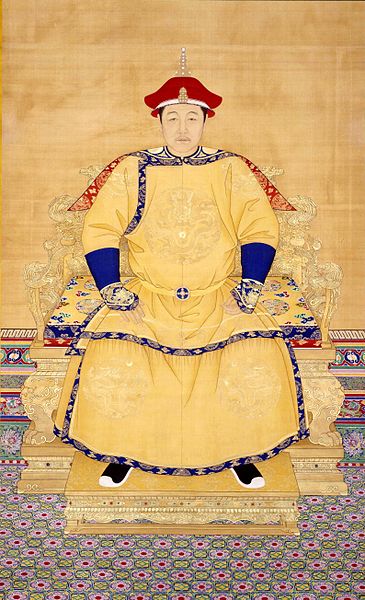
Image Source: Public Domain
About Shunzhi Emperor
Lifespan: 1638 – 1661 A.D
Reign Years: 1643 – 1661 A.D
Given Name: Fulin
Reign Name: Shìzu

Image Source: Public Domain
Lifespan: 1638 – 1661 A.D
Reign Years: 1643 – 1661 A.D
Given Name: Fulin
Reign Name: Shìzu
Fu Lin was called the Shunzhi Emperor and was the second ruler of the Qing Dynasty. He was also the very first emperor to rule over the country proper from 1644 to 1661.
Shunzhi Emperor was a diligent, smart, and decisive monarch who appeased the resistance of the late Ming Dynasty’s people. He implemented several policies that assisted the recovery of the economy and agriculture.
Go back in time and follow the timeline and emperors of the Qing Dynasty.
Read MoreFu Lin was still young when his father, Hong Taiji, died. Because of this, it caused a lot of tension and issues over the throne. Mainly, it was between his uncle Dorgon and his older brother.
A board of Manchu princes opted Fu Lin to succeed the throne in 1643. They even appointed co-regents, namely Dorgon, the 14th son of Nurhaci, and Jirgalang, Nurhaci’s nephew. The two were known to be members of the Qing imperial clan.
Soon, Fu Lin ascended the throne as the Shunzhi Emperor at just 6-years-old, then eventually moved into the Forbidden Palace. Specifically, it was after the Qing Empire began its rule as a national authority in the country’s history.
Rare and unique Chinese antique blue and white porcelain Ming dynasty vase, the lower part of the vase is shaped as a big bowl decorate with foo dogs surrounded by clouds, in the center of the vase phoenix birds are painted in blue surrounded by peony blossom alternatively rendered and in profile.
Buy Now!Remarkable and rare made of high quality blue and white porcelain this dragon vase is from the early Ming dynasty, the vase is decorated with clouds and peony blossom and remarkable work of a dragon in clay. It has a long cover in perfect condition. The clay has a small chip near one of the dragon 3 claw hands
Buy Now!This antique blue and white porcelain plate features a beautiful and complex inverted painting with rich blue tone colors in the center, surrounded by a double ring peony blossom alternatively rendered and in profile, In the outer rim there is a painting in blue on white leaves surrounding the entire plate.
Buy Now!During his short reign, the Shunzhi Emperor created a couple of precedents, which defined the Qing dynasty.
For about seven years, the political power was mostly in the hands and control of Dorgon. Under his rule, the Qing Empire was able to conquer most territories of the fallen Ming. During this time, he was able to chase Ming loyalists deep into the area’s southwest provinces.
The Qing’s troops continued winning and expanding. However, it was simultaneous to the many wide-scale inhumane massacres that occurred in defeated areas.
He established and settled the basis of Qing’s rule over China, despite the unpopular policies present like the hair-cutting command. It forced the Qing people to shave most of their frontal hair. Then, they’d braid the remaining hair into a queue that appeared like the Manchus.
After the death of Dorgon, the Shunzhi Emperor began ruling the empire personally.
The 13-year-old Shunzhi Emperor acquired and expanded centralized power. He set a collection of etiquettes and administration systems according to the late Ming’s governance.
In the 1650s, he faced a revival of the Ming loyalist group. However, by 1661, his troops defeated the Qing Empire’s final enemies. These were Koxinga and the Prince of Gui from the Southern Ming dynasty.
He encouraged the Han-Chinese in the government to participate while aiming for other policies for support from Chinese intellectuals. These include reinstating the Confucian curriculum and civil service exams.
To deter the possible challenges to the imperial court’s authority, the Shunzhi Emperor commanded the Upper Three of the Eight Banners to be set under his direct control.
In 1652, the Qing Dynasty emperor welcomed the 5th Dalai Lama and granted him an honorific title. He even provided a gold certificate of appointment and a gold seal of authority.
At some point, this Qing Empire emperor was even noted for taking a Jesuit from Germany as his personal advisor and mentor. He was Johann Adam Schall von Bell, and he mentored the emperor on subjects like technology, astronomy, and the government.
Richly decorated and full of interesting details, this rare vase from the late Ming Dynasty seeks to imitate the drawing style of the Yuan Dynasty. The base is adorned with elegant arches that makes way for a seductive waisted body.
Buy Now!This blue and white porcelain plate is finely painted in light cobalt tones, flower blossom is painted in the center surrounded by double enclosed ring with three gates. The plate show rust spots and it is marked at the bottom.
Buy Now!Antique Chinese Red underglazed porcelain Kendi, the body is painted with fish swimming surrounded by plants and flowers, the bottom is marked with a couch shell a symbol of royalty, dignity and high rank.
Buy Now!The Shunzhi Emperor died because of smallpox when he was only 22-years-old. Then, smallpox was an extremely contagious disease that was endemic in the country.
After his death, he was succeeded by Xuanye, his third son, who survived from smallpox. He ruled the Qing Empire for 60 years under the name Emperor Kangxi.
Only a couple of documents were left from the Shunzhi Emperor’s era compared to the Qing’s later eras. So, the Shunzhi period was a lesser-known time of the Qing Empire’s history.
Join the VIP club, Get Auction notification, special offers and more!